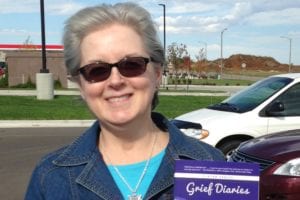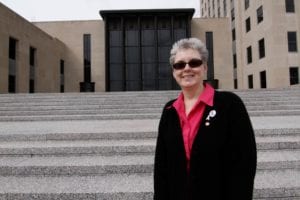

It started in 1988 with some pain in the rib cage, called costochondritis. It actually got so bad that Brenda Kleinsasser, now 58, had surgery performed by a heart surgeon to remove some of the cartilage he thought was causing the pain.
Fast-forward a couple years later, to 1990 — that’s when the foot pain began. “My feet started hurting so bad. I thought I just needed to get good shoes,” says Kleinsasser, who lives in Bismarck, North Dakota. She was told she might have plantar fasciitis, though she was never diagnosed.
Within a year, her ankles were so swollen it became hard to get into shoes. “If I took my shoes off, there was no way I’d be able to get them back on,” Kleinsasser recalls.
The small joints in her my wrists and fingers began to ache and feel stiff. “I had a trigger finger in my left pinkie, where I would have to move it with my other fingers to get it back to where it should be,” she says. Her fingers became so swollen that it was hard to wear rings. Even her knees became involved; they would swell up, making it hard to walk the half-mile trip to her nearby office.
When Kleinsasser went to see her doctor, her regular primary care physician happened to not be there that day. “So I saw this other doctor who had the presence of mind to run a rheumatoid factor [blood test].” The RA factor was sky high — so she was told to see a rheumatologist for more testing.
On May 8, 1991, Kleinsasser had the rheumatologist appointment that changed her life. However, the doctor actually never came out and told her what disease she had. After what seemed like a thorough examination, Kleinsasser left his office and the nurse handed her about 10 different pamphlets — each of them about some aspect of rheumatoid arthritis.
Kleinsasser had her answer — and was in shock.
“I walked out of there that day, I had to go back to work,” says Kleinsasser, who was 31 years old, working as a receptionist at a medical clinic. “Knowing the stories of RA, seeing people’s hands being all crippled. This is all running through my mind — my life is over, I thought. I’m not going to be able to work.”
Adapting to Life with RA
“I pretty much cried the entire first month. I didn’t know how to deal with it. There was no social media at that time,” Kleinsasser says. “The only resource I had was Arthritis Today magazine. I went to the public library and checked out VHS tapes to find out what people do to adapt to living with RA. I had no idea.”
She started making adjustments to make daily life easier, such as a stool for the kitchen so she could sit while she washed her dishes. “Standing was pure agony,” Kleinsasser says. She started using a cane to help her walk to work.
Kleinsasser’s disease was progressing and she needed to start medication, so she was prescribed methotrexate, which she took along with NSAIDs for nearly five years — but the drugs took a toll on her body. The NSAIDs upset her stomach; the methotrexate seemed to be thinning her hair and causing chronic sinus issues. So she stopped them, except for a prescription NSAID, and tried to cope as best she could.
The Question that Changed Everything
By the year 2000, Kleinsasser was seeing a different primary care doctor. After he looked over her records, the very first question he asked her was this: “Have you ever considered taking Enbrel?”
It was the first biologic drug approved for rheumatoid arthritis in 1998. It took her a few months to think about it and decide she was ready to try it. At the time the drug was in such demand, Kleinsasser recalls, you had to register for it and be put on a waiting list.
On April 13 — “a Friday, of all things” — Kleinsasser got a call asking if she was ready to start taking Enbrel (etanercept). She had her very first injection the following week.
Within a couple of weeks she could tell it was working. “My wrist didn’t hurt. I had been wearing a splint because my wrist was so bad. I didn’t have to wear it anymore. People noticed my walking was so much better,” she says.
“I’ve been on Enbrel for 17 years now,” Kleinsasser says, “and I really do believe this is what’s helped me keep working full-time.”
A Journal to Track It All
You might be marveling at Kleinsasser’s memory: She can tell you the exact days of various doctor’s appointments and treatment updates. And the reason is her treatment diary.
She’s kept a log from day one. Every single biologic injection she’s ever had is documented there. “It was one of my coworker’s ideas, and it was the best idea ever,” she says. “We worked in accounting at the time. We felt that keeping records is a good thing to do. It comes from the job.”
That diligent record keeping served Kleinsasser well as she moved in to the next chapter of her life with RA: patient advocate.

Telling a Story, and Making a Difference
After she started taking Enbrel, Kleinsasser started Googling support groups for other people on the drug — and that’s how she found CreakyJoints and the Global Healthy Living Foundation.
After reading message board posts, articles, and newsletters for years, Kleinsasser saw a Facebook post one day in 2012 that caught her attention: “Do you deal with RA in the workplace?” it asked. Her first thought: I sure do. Her second: Do I really want to get involved and do something like this?
We’re thankful she decided to say yes. Over time, Kleinsasser became one of the first members of our grassroots patient advocacy organization, the 50-State Network. GHLF worked with Brenda to set up an advocacy day for her to share her story with staff members of North Dakota’s senatorial and congressional offices.
“I got to pick the day,” she says. “So I picked April 20, 2012, the 11th anniversary of my first Enbrel injection. We centered the whole day around that.” (The above photo of Kleinsasser near North Dakota’s Capitol Building was taken that day.)
“I swallowed my nerves and told my story over and over again of how a biologic had given me new life,” Brenda wrote in an essay about the experience. “I talked about how the medication was also easy to administer with an auto injector, which meant I did not have to go to an infusion center and take time out of my life … I talked about how I was still in pain pretty much 24/7 but that this medication allowed me to be able to remain mobile.”
By working with GHLF to share her story with legislators about how being on her biologic has improved her health, Kleinsasser played a critical role in the development of legislation in North Dakota that protects patients’ rights to be notified if their biologic were to be switched to a biosimilar (a “generic” version of the drug). North Dakota was among the first six states to pass such legislation, which has now been widely enacted across the U.S. (You can read more about these laws here.)
Today, Kleinsasser remains active with GHLF and CreakyJoints as a member of our Patient Council advisory group, which helps create and disseminate patient-centered communication and educational materials.
Her experience as a patient advocate with GHLF also motivated her to coauthor a book called The Grief Diaries, shown above, about her experience overcoming the brain tumor she was diagnosed with in 2008.
“It’s not easy living with rheumatoid arthritis but the path of advocacy, raising my voice and demanding to be heard, being part of a patient-led research initiative to find a cure, have not only helped give me a sense of satisfaction and control — it has given me hope,” Brenda wrote in her essay.
From Helpless to Hopeful
Taking a game-changing biologic and being a part of a supportive arthritis community made all the difference for Brenda Kleinsasser in terms of her outlook for living well with rheumatoid arthritis.
“They say that if you’re gonna get RA, now’s the time to get it, and I couldn’t agree more,” Kleinsasser says. Not just because of all the new classes and kinds of medication available, but because of the access to support. “Support is the number one thing. How I found CreakyJoints.”
Today, Kleinsasser says she’s a much more positive person than when she was diagnosed in 1991.
“You can live with RA. That’s the point. I don’t like to say that I suffer from RA. I don’t like that terminology. I say that I live with it,” she says. “I’m very real about it. I have my days where I need my rest and that’s what I do. If I feel I can’t go to work or it’s too dangerous for me to move around and I feel like I might fall, I call and say I can’t make it today. I’m fighting too when I’m resting because I’m listening to my body.”
Kleinsasser’s best tip for coping with the ups and downs of manging a chronic illness is to write about it. She just started her 11th journal a couple of months ago. “I like to get my feelings down on paper,” she says.
When asked what she would say to someone newly diagnosed with RA, Kleinsasser’s message is simple yet powerful: “There’s hope.”
Get Involved
You can connect with CreakyJoints and our parent nonprofit, the Global Healthy Living Foundation, in a few different ways.
- Register with CreakyJoints to get our newsletters
- Download our app, ArthritisPower, to track your arthritis symptoms
- Join the 50-State Network to become a patient advocate like Brenda





